Ahmed Imtiaz Humayun
Learning Transferable Features for Implicit Neural Representations
Sep 15, 2024Abstract:Implicit neural representations (INRs) have demonstrated success in a variety of applications, including inverse problems and neural rendering. An INR is typically trained to capture one signal of interest, resulting in learned neural features that are highly attuned to that signal. Assumed to be less generalizable, we explore the aspect of transferability of such learned neural features for fitting similar signals. We introduce a new INR training framework, STRAINER that learns transferrable features for fitting INRs to new signals from a given distribution, faster and with better reconstruction quality. Owing to the sequential layer-wise affine operations in an INR, we propose to learn transferable representations by sharing initial encoder layers across multiple INRs with independent decoder layers. At test time, the learned encoder representations are transferred as initialization for an otherwise randomly initialized INR. We find STRAINER to yield extremely powerful initialization for fitting images from the same domain and allow for $\approx +10dB$ gain in signal quality early on compared to an untrained INR itself. STRAINER also provides a simple way to encode data-driven priors in INRs. We evaluate STRAINER on multiple in-domain and out-of-domain signal fitting tasks and inverse problems and further provide detailed analysis and discussion on the transferability of STRAINER's features. Our demo can be accessed at https://colab.research.google.com/drive/1fBZAwqE8C_lrRPAe-hQZJTWrMJuAKtG2?usp=sharing .
Self-Improving Diffusion Models with Synthetic Data
Aug 29, 2024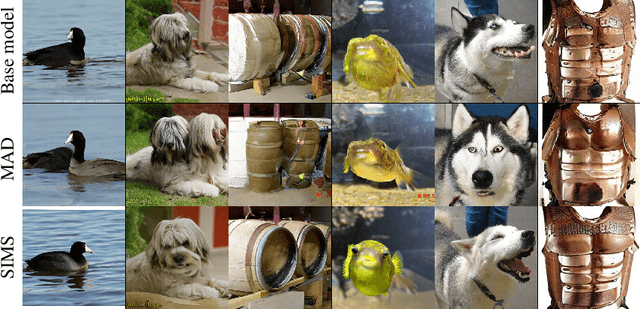
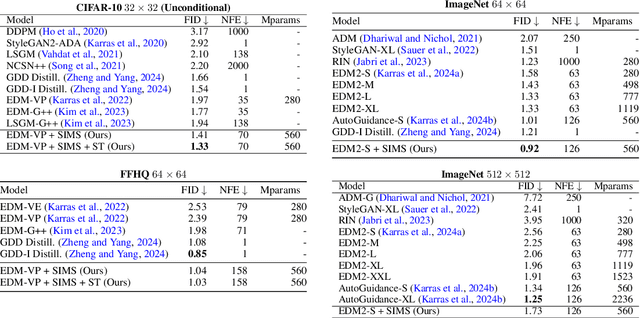
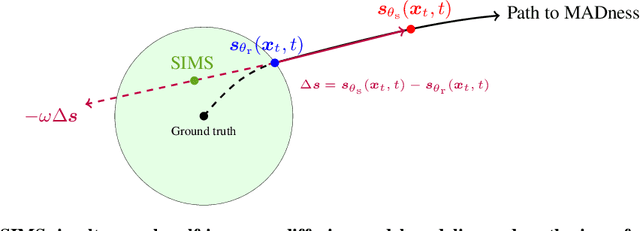
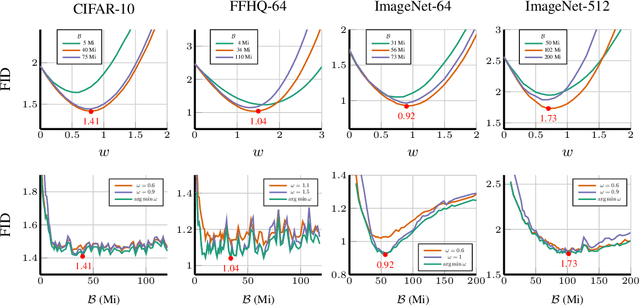
Abstract:The artificial intelligence (AI) world is running out of real data for training increasingly large generative models, resulting in accelerating pressure to train on synthetic data. Unfortunately, training new generative models with synthetic data from current or past generation models creates an autophagous (self-consuming) loop that degrades the quality and/or diversity of the synthetic data in what has been termed model autophagy disorder (MAD) and model collapse. Current thinking around model autophagy recommends that synthetic data is to be avoided for model training lest the system deteriorate into MADness. In this paper, we take a different tack that treats synthetic data differently from real data. Self-IMproving diffusion models with Synthetic data (SIMS) is a new training concept for diffusion models that uses self-synthesized data to provide negative guidance during the generation process to steer a model's generative process away from the non-ideal synthetic data manifold and towards the real data distribution. We demonstrate that SIMS is capable of self-improvement; it establishes new records based on the Fr\'echet inception distance (FID) metric for CIFAR-10 and ImageNet-64 generation and achieves competitive results on FFHQ-64 and ImageNet-512. Moreover, SIMS is, to the best of our knowledge, the first prophylactic generative AI algorithm that can be iteratively trained on self-generated synthetic data without going MAD. As a bonus, SIMS can adjust a diffusion model's synthetic data distribution to match any desired in-domain target distribution to help mitigate biases and ensure fairness.
Understanding the Local Geometry of Generative Model Manifolds
Aug 15, 2024



Abstract:Deep generative models learn continuous representations of complex data manifolds using a finite number of samples during training. For a pre-trained generative model, the common way to evaluate the quality of the manifold representation learned, is by computing global metrics like Fr\'echet Inception Distance using a large number of generated and real samples. However, generative model performance is not uniform across the learned manifold, e.g., for \textit{foundation models} like Stable Diffusion generation performance can vary significantly based on the conditioning or initial noise vector being denoised. In this paper we study the relationship between the \textit{local geometry of the learned manifold} and downstream generation. Based on the theory of continuous piecewise-linear (CPWL) generators, we use three geometric descriptors - scaling ($\psi$), rank ($\nu$), and complexity ($\delta$) - to characterize a pre-trained generative model manifold locally. We provide quantitative and qualitative evidence showing that for a given latent, the local descriptors are correlated with generation aesthetics, artifacts, uncertainty, and even memorization. Finally we demonstrate that training a \textit{reward model} on the local geometry can allow controlling the likelihood of a generated sample under the learned distribution.
On the Geometry of Deep Learning
Aug 09, 2024



Abstract:In this paper, we overview one promising avenue of progress at the mathematical foundation of deep learning: the connection between deep networks and function approximation by affine splines (continuous piecewise linear functions in multiple dimensions). In particular, we will overview work over the past decade on understanding certain geometrical properties of a deep network's affine spline mapping, in particular how it tessellates its input space. As we will see, the affine spline connection and geometrical viewpoint provide a powerful portal through which to view, analyze, and improve the inner workings of a deep network.
ScaLES: Scalable Latent Exploration Score for Pre-Trained Generative Networks
Jun 14, 2024Abstract:We develop Scalable Latent Exploration Score (ScaLES) to mitigate over-exploration in Latent Space Optimization (LSO), a popular method for solving black-box discrete optimization problems. LSO utilizes continuous optimization within the latent space of a Variational Autoencoder (VAE) and is known to be susceptible to over-exploration, which manifests in unrealistic solutions that reduce its practicality. ScaLES is an exact and theoretically motivated method leveraging the trained decoder's approximation of the data distribution. ScaLES can be calculated with any existing decoder, e.g. from a VAE, without additional training, architectural changes, or access to the training data. Our evaluation across five LSO benchmark tasks and three VAE architectures demonstrates that ScaLES enhances the quality of the solutions while maintaining high objective values, leading to improvements over existing solutions. We believe that new avenues to LSO will be opened by ScaLES ability to identify out of distribution areas, differentiability, and computational tractability. Open source code for ScaLES is available at https://github.com/OmerRonen/scales.
Deep Networks Always Grok and Here is Why
Feb 23, 2024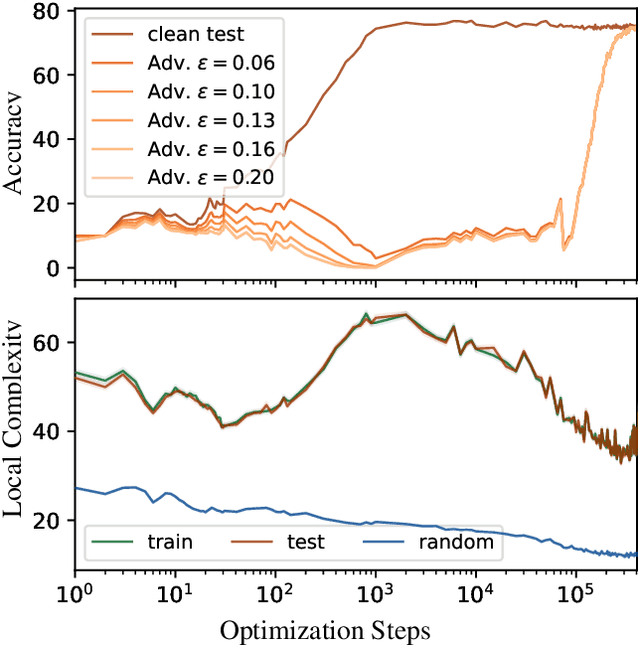

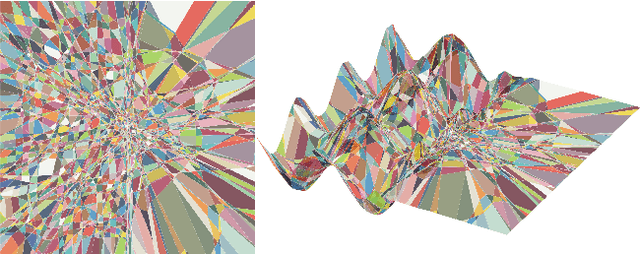

Abstract:Grokking, or delayed generalization, is a phenomenon where generalization in a deep neural network (DNN) occurs long after achieving near zero training error. Previous studies have reported the occurrence of grokking in specific controlled settings, such as DNNs initialized with large-norm parameters or transformers trained on algorithmic datasets. We demonstrate that grokking is actually much more widespread and materializes in a wide range of practical settings, such as training of a convolutional neural network (CNN) on CIFAR10 or a Resnet on Imagenette. We introduce the new concept of delayed robustness, whereby a DNN groks adversarial examples and becomes robust, long after interpolation and/or generalization. We develop an analytical explanation for the emergence of both delayed generalization and delayed robustness based on a new measure of the local complexity of a DNN's input-output mapping. Our local complexity measures the density of the so-called 'linear regions' (aka, spline partition regions) that tile the DNN input space, and serves as a utile progress measure for training. We provide the first evidence that for classification problems, the linear regions undergo a phase transition during training whereafter they migrate away from the training samples (making the DNN mapping smoother there) and towards the decision boundary (making the DNN mapping less smooth there). Grokking occurs post phase transition as a robust partition of the input space emerges thanks to the linearization of the DNN mapping around the training points. Website: https://bit.ly/grok-adversarial
Training Dynamics of Deep Network Linear Regions
Oct 19, 2023



Abstract:The study of Deep Network (DN) training dynamics has largely focused on the evolution of the loss function, evaluated on or around train and test set data points. In fact, many DN phenomenon were first introduced in literature with that respect, e.g., double descent, grokking. In this study, we look at the training dynamics of the input space partition or linear regions formed by continuous piecewise affine DNs, e.g., networks with (leaky)ReLU nonlinearities. First, we present a novel statistic that encompasses the local complexity (LC) of the DN based on the concentration of linear regions inside arbitrary dimensional neighborhoods around data points. We observe that during training, the LC around data points undergoes a number of phases, starting with a decreasing trend after initialization, followed by an ascent and ending with a final descending trend. Using exact visualization methods, we come across the perplexing observation that during the final LC descent phase of training, linear regions migrate away from training and test samples towards the decision boundary, making the DN input-output nearly linear everywhere else. We also observe that the different LC phases are closely related to the memorization and generalization performance of the DN, especially during grokking.
Self-Consuming Generative Models Go MAD
Jul 04, 2023Abstract:Seismic advances in generative AI algorithms for imagery, text, and other data types has led to the temptation to use synthetic data to train next-generation models. Repeating this process creates an autophagous (self-consuming) loop whose properties are poorly understood. We conduct a thorough analytical and empirical analysis using state-of-the-art generative image models of three families of autophagous loops that differ in how fixed or fresh real training data is available through the generations of training and in whether the samples from previous generation models have been biased to trade off data quality versus diversity. Our primary conclusion across all scenarios is that without enough fresh real data in each generation of an autophagous loop, future generative models are doomed to have their quality (precision) or diversity (recall) progressively decrease. We term this condition Model Autophagy Disorder (MAD), making analogy to mad cow disease.
OOD-Speech: A Large Bengali Speech Recognition Dataset for Out-of-Distribution Benchmarking
May 15, 2023Abstract:We present OOD-Speech, the first out-of-distribution (OOD) benchmarking dataset for Bengali automatic speech recognition (ASR). Being one of the most spoken languages globally, Bengali portrays large diversity in dialects and prosodic features, which demands ASR frameworks to be robust towards distribution shifts. For example, islamic religious sermons in Bengali are delivered with a tonality that is significantly different from regular speech. Our training dataset is collected via massively online crowdsourcing campaigns which resulted in 1177.94 hours collected and curated from $22,645$ native Bengali speakers from South Asia. Our test dataset comprises 23.03 hours of speech collected and manually annotated from 17 different sources, e.g., Bengali TV drama, Audiobook, Talk show, Online class, and Islamic sermons to name a few. OOD-Speech is jointly the largest publicly available speech dataset, as well as the first out-of-distribution ASR benchmarking dataset for Bengali.
BaDLAD: A Large Multi-Domain Bengali Document Layout Analysis Dataset
Mar 10, 2023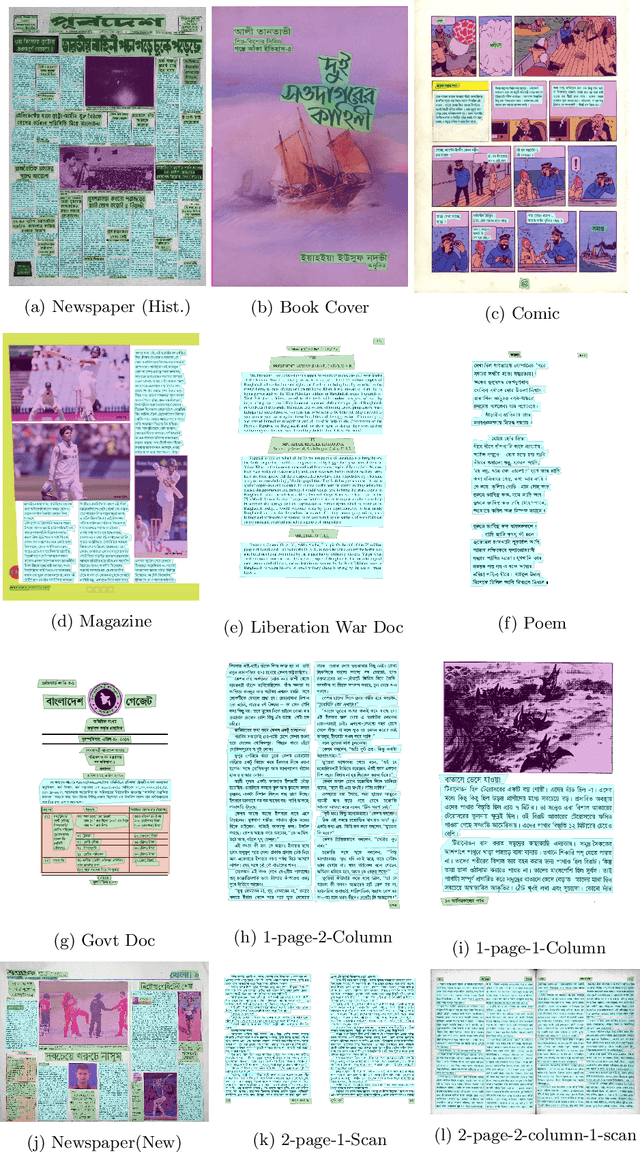

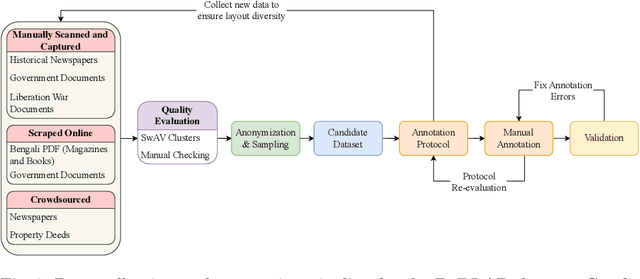

Abstract:While strides have been made in deep learning based Bengali Optical Character Recognition (OCR) in the past decade, the absence of large Document Layout Analysis (DLA) datasets has hindered the application of OCR in document transcription, e.g., transcribing historical documents and newspapers. Moreover, rule-based DLA systems that are currently being employed in practice are not robust to domain variations and out-of-distribution layouts. To this end, we present the first multidomain large Bengali Document Layout Analysis Dataset: BaDLAD. This dataset contains 33,695 human annotated document samples from six domains - i) books and magazines, ii) public domain govt. documents, iii) liberation war documents, iv) newspapers, v) historical newspapers, and vi) property deeds, with 710K polygon annotations for four unit types: text-box, paragraph, image, and table. Through preliminary experiments benchmarking the performance of existing state-of-the-art deep learning architectures for English DLA, we demonstrate the efficacy of our dataset in training deep learning based Bengali document digitization models.
 Add to Chrome
Add to Chrome Add to Firefox
Add to Firefox Add to Edge
Add to Edge